Sight Sound Blog About @Seaboardist
Face the Music
A few days ago, I received an email asking “When do we get to hear that rig?” I have to admit that’s a damn good question. I’ve had music recorded and ready to go for a while now, but held off on posting it for reasons I’ll explain shortly.
No more delays; here’s the first piece I recorded using the Seaboard Grand. I call it Game of Glass, and it’s an arrangement of Ramin Djawadi’s main title music for HBO’s Game of Thrones.
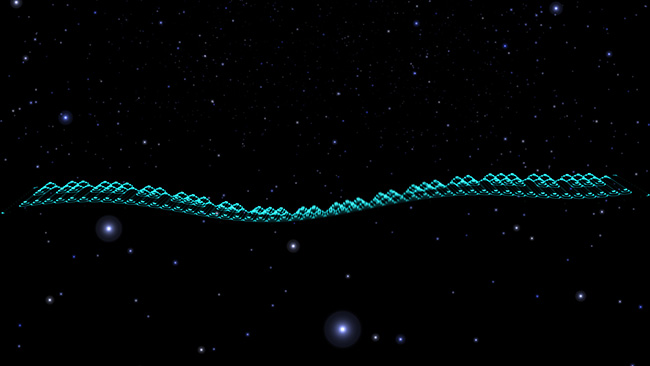
I’ve reimagined it as if it was composed in the style of Philip Glass. The original was in 6/8, but this version is in 21/8, divided 5/5/5/6.
My primary intention with this piece was to test using the Seaboard as a studio production tool, without getting caught up in the process of composing my own work. It was important to me to play everything using the Seaboard, simply to see if it could be done. And that’s what I wound up doing, with the exception of a few drum tracks played by hand on the head of the Korg Wavedrum, using a patch called “Viking War Drums.” Even so, most of the drum tracks were still performed on the Seaboard.
As a result, the piece really doesn’t show off the unique capabilities of the instrument. You can hear it in the solo cello line at the beginning, and in some ribbon sweeps here and there; but as far as really using the Seaboard for expression, this is just the equivalent of kicking the tires and taking it out around the track for a few laps.
I’m hoping most people will make the effort to download this 48K/24-bit version of the track. If your system won’t support 24-bit, there's also a 16-bit version.
Game of Glass, 48k/24-bit AIFF
Game of Glass, 48k/16-bit AIFF
For those who would rather just click and play – or are listening on a lo-fi system where it just doesn’t matter – here’s a Soundcloud link. Unfortunately, Soundcloud does pretty nasty things to musical audio.
However you listen, please turn it up! As the saying goes, this was “made loud to be played loud.” And in truth, this is just the first step on a path I’ll be walking for many years to come.
I had originally planned to complete an animation to accompany this music, which would allow me to distribute it more effectively on sites such as Vimeo and YouTube. To expedite things, I thought I’d use simple wire-frame graphics, rendered in After Effects using a new plug-in I’d found. This would save me a tremendous amount of time doing shaded renders.
Well, that was the theory. And the renders were very fast. The problem was that I really didn’t do in-depth testing of the workflow before I got going; though After Effects has a fairly robust 3D system, using my chosen plug-in threw a wrench in the works.
The problem was that I could only see what I was animating from the camera’s point of view. If I wanted to look at the entire set from above, or the side, or the front, all I could see was an empty rectangle.
This made the process of positioning objects and generating key frames an excruciating time sink. I persevered, but eventually hit the wall and gave myself some time off. After that, despite being in denial for a while, I eventually had to admit that I simply didn’t have the stomach to continue the process. I had completed roughly 2/3 of the animation, and didn’t care for the idea of leaving it unfinished, but what I really wanted to do was play the Seaboard!
So here’s what was completed when I threw up my hands and walked away. Please don’t distribute or post this elsewhere; as you’ll see, there’s a gaping black hole in the middle I don’t plan on filling. The next time I take on a 3D project, I’ll make sure the workflow doesn’t contain any unpleasant surprises first.
(When the new window opens, please click the green “maximize” button in the upper left corner; the animation is 1920x1080. Yes, I know I should code it, but for right now, I just want to get this posted! I'll tweak it later.)
The unfinished Game of Glass animation
In the Studio
It’s been far too long since my last update; it’s time to bring things current, and let everyone know what’s been going on.
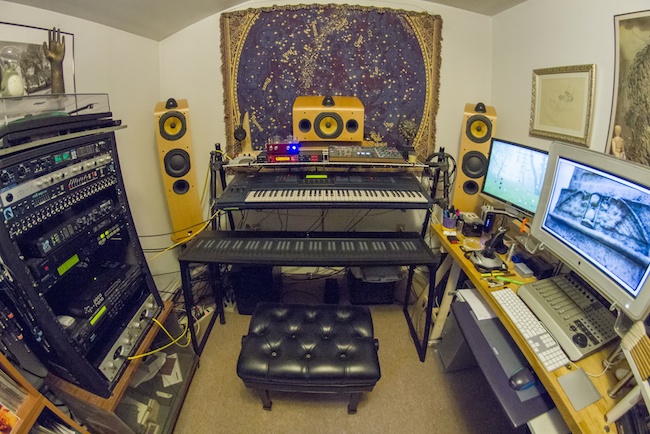
The primary reasons for the delay have been my complete immersion in two projects: my first studio recording using the Seaboard as a controller, and the animation that will accompany it when I release it online.
The music has been completed for several weeks, but after rushing to meet a self-imposed deadline on the animation – and finding myself doing work I was less than satisfied with – I’m taking a few days to step back from the project, and give myself a restorative break. So now there’s no excuse not to bring things up to date!
The Seaboard has been moved from its arrival space in the living room, and settled into its long-term location in the studio. It’s a tight fit, but it actually works out very well, and I love having my solid piano stool available for both the Seaboard and the Yamaha piano keyboard controller again.
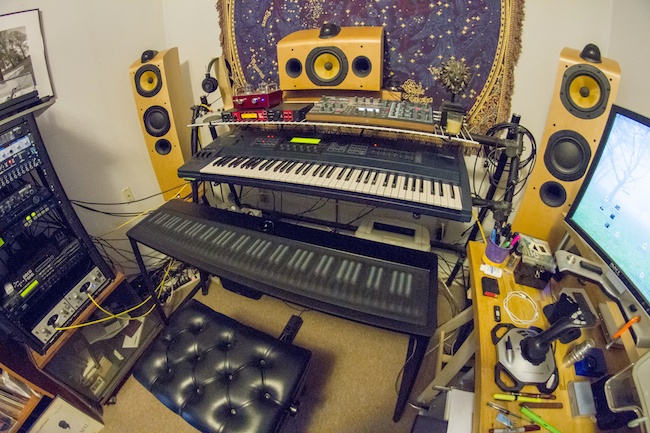
Since I can close the door to the studio, I’m much less concerned about needing to protect the Seaboard from Milla the cat. The door is only open when I’m actually in there working, and she’s happy to hang out under the piano instead of trying to climb up on things. The cover I made still does a good job of keeping the keywave surface relatively dust-free.
I’m going to stay mum for the time being about the first piece of music I recorded using the Seaboard, except to say that it’s an arrangement of someone else’s work; I wanted to get the feel of using the instrument as a production tool before I started using it for serious composition. I’ve gone to the necessary effort to do it legally, as well; I’ve paid licensing fees for streaming rights, and will continue to pay more as the the hit count rises. (If I’m lucky enough to get that much traffic!)
I’m over halfway through the animation that will accompany it; I expect to get going again by the weekend, so it shouldn’t be much longer before I have the finished work to share. I’ll have more to say about it when it’s ready. I can promise that the second piece I record will be entirely original!

As I type this, the folks from ROLI are wrapping up their get-together at Abbey Road Studios – yes, that Abbey Road – and I hope everyone had a fantastic time. In addition to showing off various versions of the Seaboard Grand, they were announcing an influx of capital from a number of investment firms, and it couldn’t happen to a nicer bunch of people! My congratulations to all.
I’ve received a higher level of dedicated support from ROLI than I’ve ever experienced in over 40 years of working with synths and other music tech. Remember, my Seaboard – LFE number A1! – was one of the very first to reach the public. There have been a number of firmware updates as they refined the functionality of the instrument, and at this point the very few “breaking in” concerns I experienced in the early days have been completely eliminated. ROLI’s attention to detail and commitment to perfection is amazing; they’ve gone the extra mile in every interaction I’ve had with them.
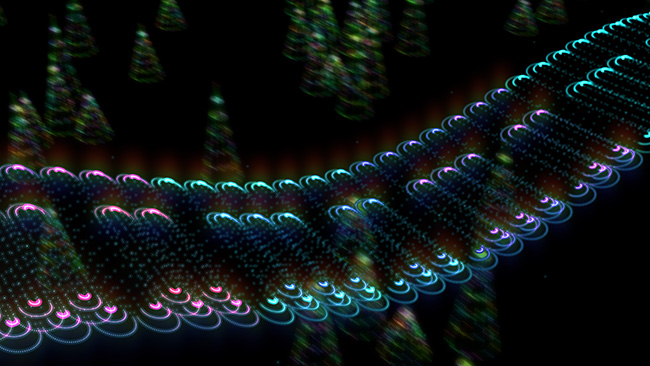
I’m eager to wrap up the animation work so I can get back to focusing on the Seaboard! I’ve developed MIDI recording techniques in Digital Performer that take maximum advantage of the Seaboard’s poly pitch bend capabilities, and I know my next session is going to be a blast.
My next post, in all likelihood, will link to the music animation I’ll be wrapping soon… please check back, or follow me on Twitter via @Seaboardist for the release announcement. Until then, ciao!
At Last, Playing
It’s been over a week since the Seaboard arrived, but this isn’t the first time I’ve started to write about it. The words don’t come easily – or there are just too many of them, all coming at once and getting stuck in the pipe – either way, there’s a lot to express and it’s been hard to know where to begin.
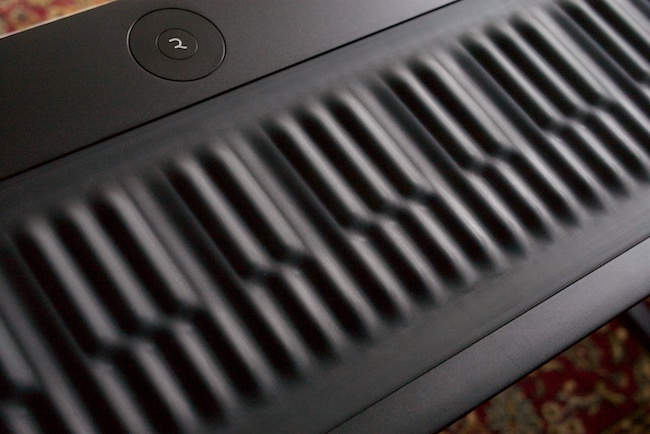
How about this: I’m amazed. Stunned. Overwhelmed. Dog paddling in the deep end of the pool. Everything I try is brand new to me, and when I start to think I’ve reached terra firma, I switch sounds and the ground recedes beneath my feet again. This isn’t a journey from point A to point B; this universe is curved – or maybe rippled. Each time I step away from the point of origin, I find myself back where I began but facing a different direction, and traveling just a little farther each time. So my progress isn’t linear; it’s more like a disc whose diameter gradually expands. Does that make any sense at all?
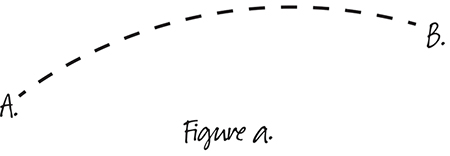
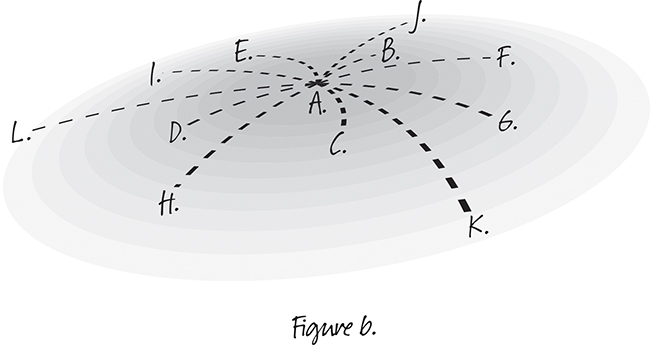
Probably not! Nor does the fact that despite sounding like this would be frustrating, I’m actually exhilarated. Over fifty years of playing keyboards and relying on muscle memory to do the work for me has given way to being present in the moment of playing each note – and remaining present even after the note has begun – because selecting the note is just the beginning. You can continue to actually play the note, just as a cellist or sax player or trumpeter would.
A side-to-side motion on the keywave surface can produce vibrato; rolling a finger up or down can bend the note from one to the next; changing the pressure as you hold the note can change the volume or alter the tone color, depending on what parameters the Seaboard is modulating in whatever synth is being played.
Right now, ROLI’s own synthesis system for the Seaboard – called Equator – is still being refined, and doesn’t currently ship with the instrument. (No complaint – it’s all part of the territory when you’re one of the early ones… !) So for the time being, I’ve been experimenting with using the Seaboard to control a number of soft synths I have running on the laptop in my living room, where the Seaboard is residing for the moment. Very soon, I’ll be moving it into my studio, where I’ll have access to my hardware synthesizers and the more powerful soft synths on my primary computer, such as Omnisphere.
When it comes to technique, the Seaboard is not a one-style-fits-all instrument; it’s absolutely essential to understand that different sounds/instruments/synthesizers require different playing styles. A percussive sound – something like a bright piano – demands a completely different touch than a bowed instrument like a cello would.
That’s one of the reasons I’m looking forward to the eventual arrival of the Equator software; the ability to edit and recall individual keywave response curves will be crucial to customizing the Seaboard for use with a range of different synthesizers and soft synths. As things are now, it’s (frankly) a blessing to be able to get used to playing the Seaboard without diving deep into customizing its response for individual patches and sounds. Still, when that ability arrives, it will be essential for personalizing and maximizing the Seaboard’s expressive capabilities.
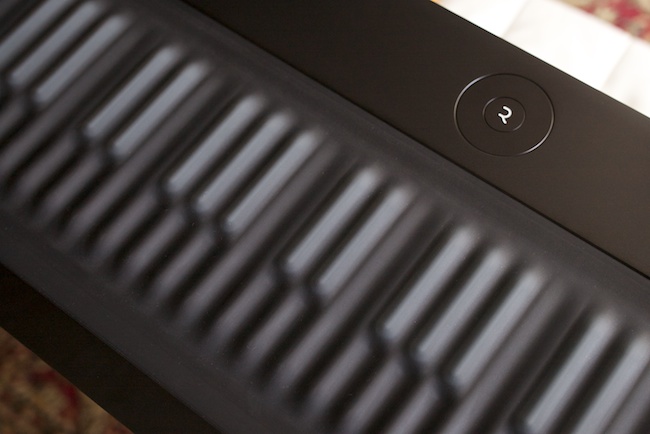
Lost in these technical considerations is one fundamental fact: playing the Seaboard is fun. Ridiculously so. It’s also surprisingly sensual, in ways that are difficult to express in words that don’t make people start to giggle.
Everyone Knows It’s Windy
Yesterday afternoon, I braved the chill of the great outdoors to try my surround rig on location. I drove to Jamestown Island and headed for Beavertail Point, a site that holds many fond memories for me.
I had hoped to get some surround samples of ocean waves breaking on the rocks, and use them in the first piece I recorded using the Seaboard.
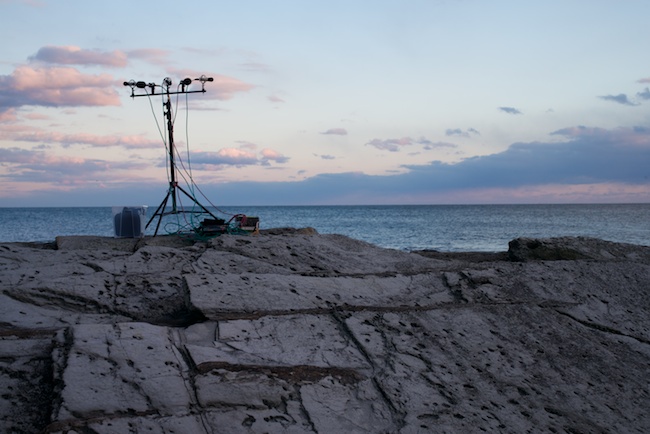
Alas, the recording just didn’t work out; the wind screens I used on the microphones just weren’t up to the task of saving the audio from wind-generated rumble. It really wasn’t a surprise; when I bought the windscreens, I knew they were for studio use, but thought I’d gamble and see how well they worked outdoors.
The good news was that during the brief intervals between wind-induced distortion, the microphones and preamps sounded great, and the surround environment in my studio had a palpable feeling of space and volume. So I’m greatly encouraged that the star-pattern technique of arranging the mics can deliver viable surround results. (Surround miking is an arcane field full of varying techniques and priorities; I’m just trying to get an immersive impression of an environment that I can use for effect, and not a phase-accurate symphonic recording.)
The “blimp” enclosures commonly used for outdoor recording can get quite expensive, and it really isn’t an option for me to buy five of them. So now the challenge will be to design and build a blimp system that creates a volume of still air for the five-microphone array. Do I construct individual tubes, or one large volume that contains all five? Whatever I build will be one unwieldy, funny-looking furry beast.
That’s a question for another day… for now, I need to come up with a different idea for that first Seaboard piece, and today I have a good block of time to dedicate to practicing. So on to it!
As I was clambering about out on the rocks, I received a phone call I’d been hoping for… the custom Parker guitar I ordered back in September is finally shipping. My friend Matt at Cascade Guitar Lab in the Pacific Northwest says it should arrive by the beginning of next week, at the latest. Here’s a shot of an earlier version of the guitar that I based my order on.
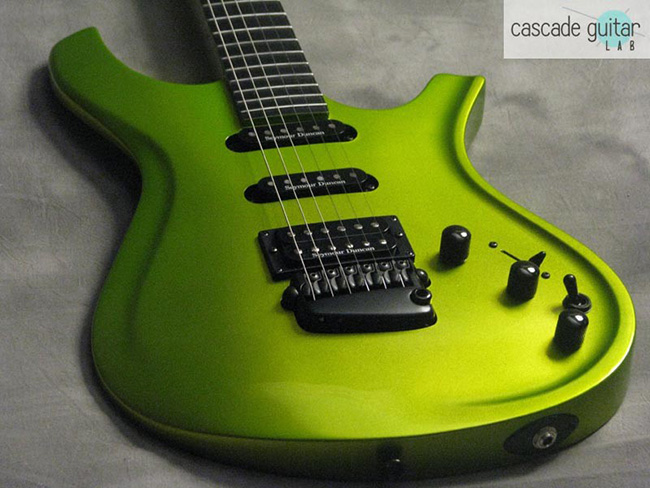
I realize I’m facing an embarrassment of musical riches at this point, but it’s a fantastic feeling. I have high hopes about what all this new fuel will do for my work. The combo of the Parker and the Axe-FX II will be unbeatable, and even though my abilities with guitar fall into “I’m not worthy!” territory, the fun I’m having could easily fill a stadium on its own.
And by the way… her name is Fern.
Settling In
Much of yesterday was occupied by the need to make a protective cover that would serve as a cat shield while the Seaboard sits out in communal space. I set out for the RISD Store and purchased a 5' sheet of black foamcore. A little cutting, a little folding, a little black vinyl tape, and violà – a nice ad hoc cover that will keep my mind at ease until Seaboard and kitty can be separated by a closed door.

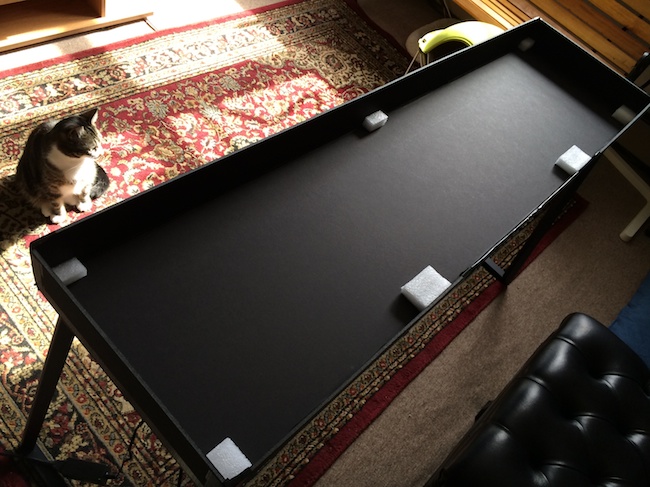
I recycled a few pieces of polyethylene foam to serve as standoffs inside the cover; they rest on the metal portions of the Seaboard’s surface, and prevent the cover from contacting the keywaves.
Just above the keywave surface is the User Dial – the only control on the Seaboard itself, other than the power on/off switch and volume fader on the rear panel. The dial lets you select different presets, without having to look away from the instrument.
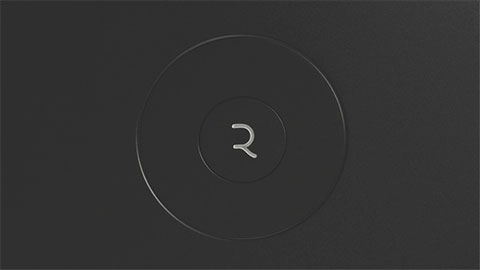
When you switch the power on, the Seaboard gives you a little light show as it starts up; I laughed out loud the first time I saw it. What a great surprise. Just click on the image of the User Dial to display a short video of the startup sequence.
I’m a lifelong Kubrick aficionado; it’s not hard to understand what I was thinking as I watched the light come to rest at the top of the User Dial.
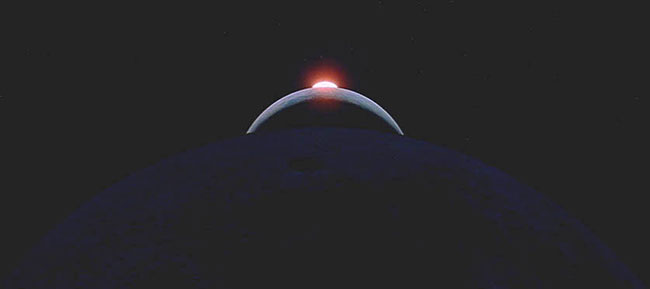
Arrival
Yesterday was one of those days that will live on in memory; I found myself thinking back to 1977, when my first polyphonic synthesizer arrived. That’s the only experience I’ve had with a new instrument that comes close to the flood of impressions from this first encounter with a Seaboard of my own.
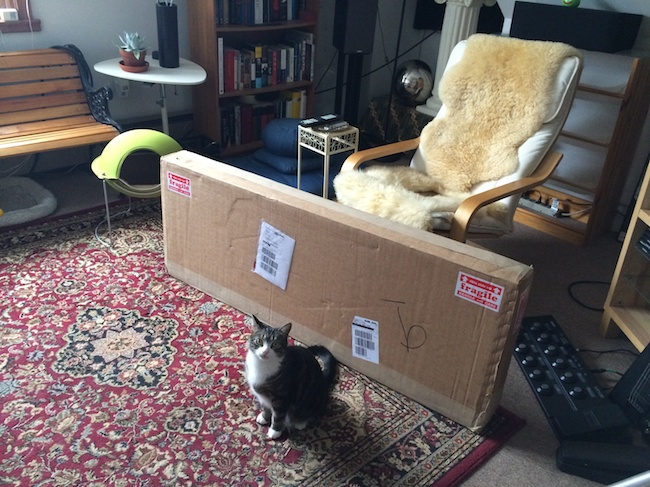
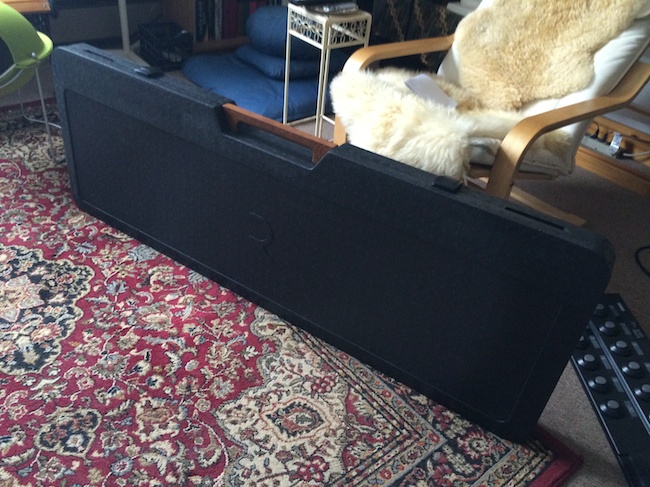
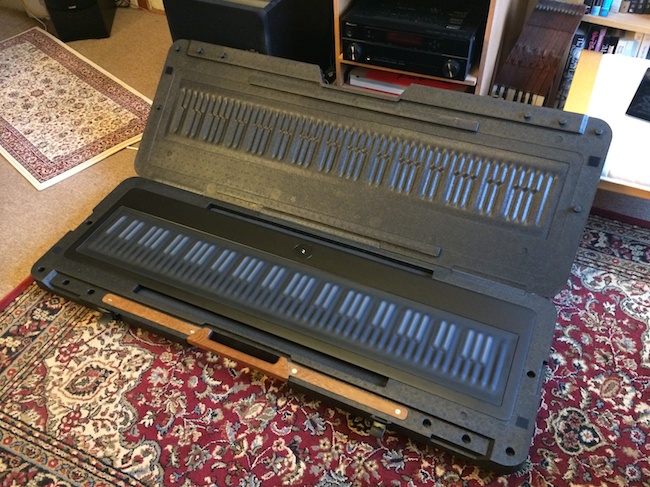
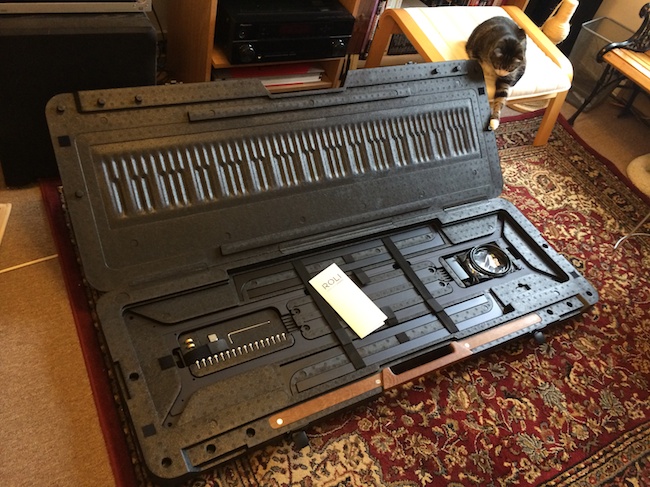
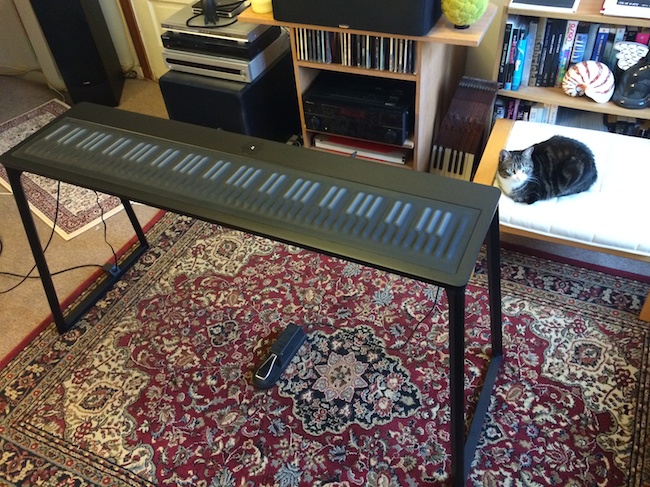
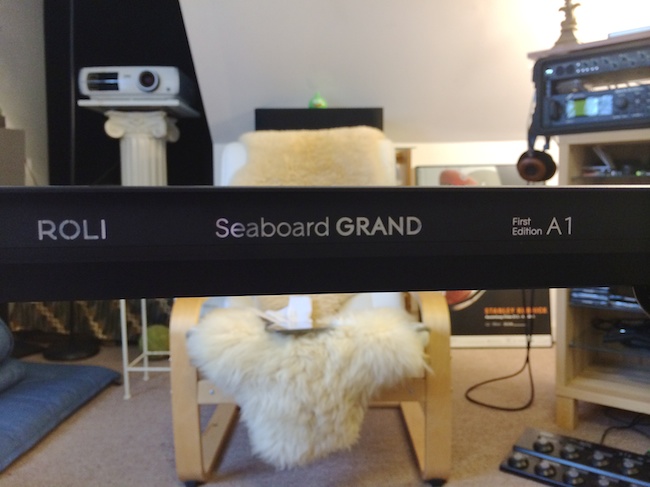
I’m not sure yet how long the Seaboard will remain in the living room before I move it into the studio; I want to dedicate some time to beginning to get used to playing the instrument. While it’s out in the open, I need to improvise a cover that can protect the playing surface from tiny cat claws when I’m not around to supervise playtime. The keywave surface is very tough and durable, but as all cat owners know, humanity has yet to invent a material that can withstand the razor-sharp ministrations of Milla, my dear little Destructo Kitty.
So that’s the first order of business. There’s so much I want to share now that the Seaboard is here, but for the moment I’ll just say that I’m still more than a little stunned by the presence of a tool that’s clearly an artifact from the future.
Visionary writer William Gibson has said “The future is already here – it’s just not very evenly distributed.” An impressive chunk of future just materialized in my living room, and it’s a genuine shock. A spectacular, challenging, dizzying joyride of a shock; I’m going to try to balance getting my thoughts together with (to paraphrase Frank Zappa) shutting up and playing my Seaboard. So please be patient with me; I’m planning to share daily updates for a while, as this initial tsunami of change subsides to normality.
For now, here’s a heartfelt “thank you” to Roland and everyone else at ROLI who are giving their all to bring something extraordinary into the world. You made it real!
Making Up for Lost Time
It’s been far too long since my last update, so let’s dive right in. It’s my intention to keep the site live and current once the Seaboard arrives, and it looks like that time is drawing nigh. ROLI has let me know they are working hard to ship in February, and I’ve never been happier that February is the shortest month. I understand that one never knows for sure with a new product launch, but I’m keeping my fingers crossed; I know everyone at ROLI is eager to get the fruit of their labors out into the world.

Interesting; I had to consciously stop myself from typing “labours.” I have the feeling there’s going to be some cultural bleed-through here between British and American spellings. I’m currently reading several British-intensive books: the third volume of The Last Lion, William Manchester’s bio of Winston Churchill; Lawrence in Arabia, a fascinating revisionist history of the formation of the modern Middle East; and Dominion, an alternate-history novel in which Britain surrendered to Germany the day before Churchill became Prime Minister in the real world (or at least our version. Not even a fictional Churchill would ever have let that kind of nasty business go down while he was PM.) All that exposure to British English is bound to add a little “colour” to my typing.
Several weeks ago, I received a special package from London; the folks at ROLI were kind enough to send me an official ROLI t-shirt and hoodie! True to their off-the-beaten-track group ethos, they enclosed a hand-written note instead of corporate letterhead; I don’t think they’ll mind if I transcribe it here:
To our friend Randy –
All the best from the ROLI team. We wanted you to be the first person not working here in London with a ROLI sweatshirt. Hope it keeps you warm and well.
As previously promised, here’s a photo of yours truly modeling said sweatshirt – and a very high-quality garment it is! I’ve been wearing it around home in lieu of turning up the heat. Thanks so much; I really appreciate it. The first time I put it on, watching in the mirror as I pulled it over my head and saw the stylized “R” appear on my chest, I had the strangest sensation… it was like that moment in a superhero origin story when the protagonist becomes aware of their destiny, and vows “to use my powers for good, not evil…!”
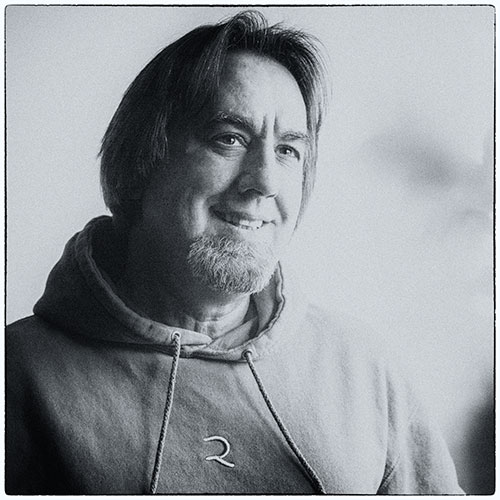
Let it be known that when it comes to haircuts, my philosophy has long been “twice a year, whether I need it or not…” Clearly, it is never a good idea to be photographed immediately after one of those infrequent occasions. Live and learn.
While we’re awaiting The Dawn of the Seaboard Age (hey, that sounds like a track from a Yes album; I’ll have to use it) there’s still plenty to keep me occupied here in the project studio.
Ever since I first worked with quad back in the ’70s at Brown University’s MacColl Studio for Electronic Music, I’ve been a surround hound. I just love the immersive and psychoacoustic properties a good surround system brings to the composer/performer. There are distribution challenges; while standards exist for surround monitoring systems, studios in general (mine included) play fast and loose with them, and once music makes it out into the real world, there’s generally no telling how your work will be played back.
If your audience is fortunate enough to actually have a multi-speaker surround system instead of one of those cursed little “surround bars,” it’s almost certainly at the mercy of the logistics of the living space. Its primary duty is inevitably soundtrack support for a home theater, and 90% of the time the subwoofer(s) will be cranked to foundation-crumbling Sensurround® levels… because they can be. That’s return on investment.
I don’t want to perpetuate a groaning relationship cliché, but it is a fact that there are disagreements between spouses/roommates about the validity of/necessity for multiple speaker enclosures and wiring (yes, I’m going there) in a space that is often perceived/defended as the sovereign territory of one party or the other. This reality can result in the tragic “compromise” of in-wall speakers, which are of so little use to anyone that the defending party is generally more than happy to allow their incursion, as the end result is truly “just like they’re not even there.” If that’s what you set out to achieve, that’s very likely just what you’ll get.
Still, you play the hand you’re dealt, and the glories and sheer joy of creating a good surround mix outweigh the unknowns. I suppose that’s just as true of monaural music in the era of free cellphone earbuds. So I persist in gearing up for as compelling a surround experience as I can possibly create.
The most recent additions are:
• A five-microphone array for on-location ambient and performance recording. Good mics get expensive in a hurry, so I expanded my existing set of Russian Oktava small-diaphragm mics, upgraded with Michael Joly’s stellar internal electronics. So now I have a matched L/R Oktava pair and a center Oktava for the front, and Michael’s own matched MJE-384 SDC mics for the rear surround pair. More about this setup in the weeks to come, when it’s not quite so frigid outside and I can do some field recording.
• To do the actual surround recording, there were a few options. I have a Metric Halo Firewire audio interface that’s superb for stereo recordings with a laptop, but upgrading to a quality portable interface that would handle five or more channels would be more of an investment than I was willing to make. And I wanted to eliminate the laptop, so I’d be able to readily use the recorder while shooting digital video.
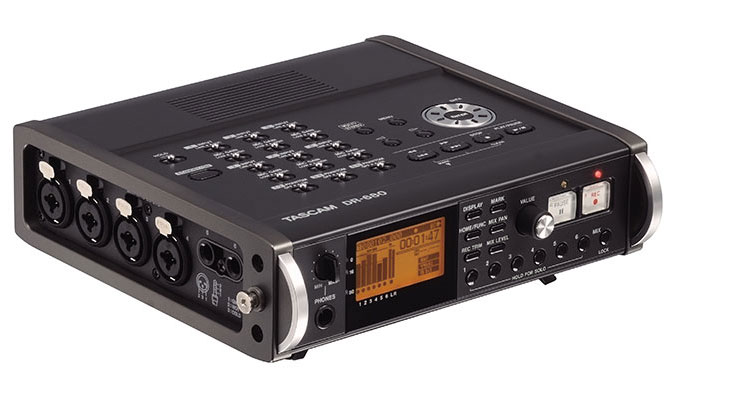
I chose the Tascam DR-680 8-channel portable field recorder, and had six preamps modified by Busman Audio to lower the noise floor by more than 8db – a very substantial improvement. It’s a fantastic little unit! It supports 96khz/24-bit recording, and is perfect for surround work. My first tests with the mic array have delivered excellent results, and I know it’s going to be a great workhorse for any number of applications. Surround sampling and environmental recording are both high on my list.
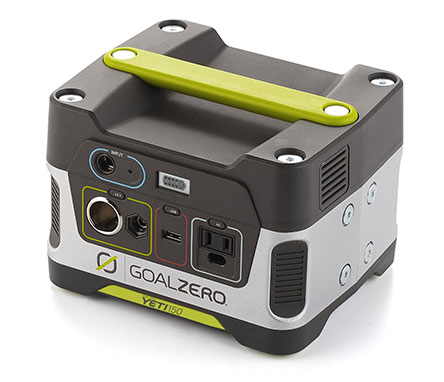
A Goal Zero Yeti 150 portable power supply will provide plenty of juice for extended recording/shooting sessions when there’s no AC available. And I haven’t forgotten Hurricane Sandy and last year’s winter storms, which resulted in power outages that sometimes lasted for several days. It’s reassuring to know I’ve got backup power on hand for the various iDevices.
• Anyone doing music production winds up with software tools they depend on like their own right hand; for many years, I’ve used Audio Ease’s Altiverb convolution reverb software. It performs flawlessly, delivers superb results, and the Audio Ease impulse response mavens continue to scour the planet, delivering an ever-expanding library of exotic environments and spaces – all for free to the end user! It’s an incredible feeling to get an email announcing that the Great Pyramid of Giza is now available as a free download. And this sort of thing continues, year after year.
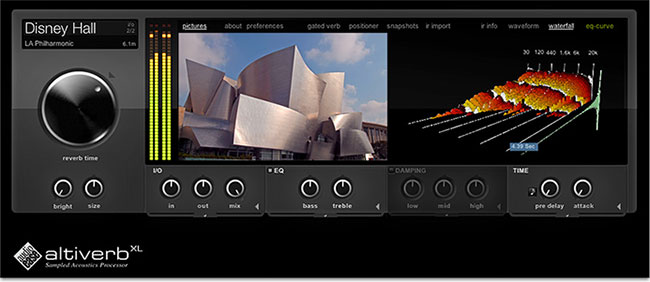
I finally upgraded from the stereo version to the XL version, which supports up to 5.1 channels and sample rates over 96k. I have some fantastic pipe organ samples from Budapest, and when I dropped them into Notre-Dame Cathedral in surround… well, it’s not hyperbole to say that it approaches religious experience. Even when I’m not recording, it’s a fantastic tool for practicing and developing ideas for new music; it transforms your perception of what you’re playing. I love this software.
• Back at Brown’s electronic music studio, we had a handmade 4-in/4-out box with four joysticks, perfect for panning sounds around a quad environment. It was also great for mixing stereo, as sounds would fade as you panned them to the unused rear channels. This memory left me less than satisfied with using a mouse to manipulate a tiny virtual surround puck onscreen. Contemporary hardware surround joysticks tend to be part of a larger control console, and are generally quite expensive.
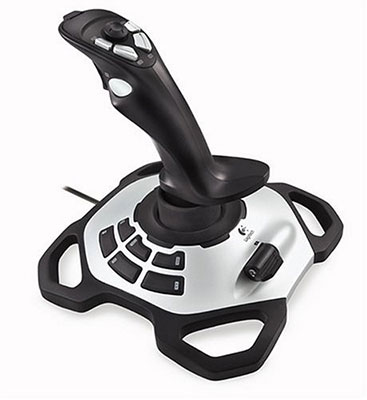
My DAW (digital audio workstation) of choice, Digital Performer, supports the use of an inexpensive USB joystick as a surround panner. I found a Logitech 3D Pro gaming joystick for all of $25, and it works like a charm – and looks wikkit cool (that’s New England talk) on my desk. It’s covered with buttons that can be assigned to all sorts of MIDI functions, and I’ve assigned the “firing trigger” to turn the panning functionality on and off. Even though the joystick is spring-loaded to automatically return to the center position, all I have to do is release the trigger, and the sound I’m panning stays exactly where I left it. Using automation, I can manipulate one track at a time into extremely complex surround motion. Now, this is the sort of thing that’s easy to overdo, but in the right circumstances, it’s a lot of fun.
• My last post described the Kyma system, and how it requires an audio interface of its own. I’ve been having great fun getting to know Kyma, and I still have a long way to go. For the time being, I’ve held off on upgrading my Mac’s older surround interface to match the Kyma’s new one – the final step that will allow me to monitor the Kyma in surround. That will come, but for now, I’ve got my hands full working with the Kyma in stereo – a perfect subject for a future post. Thus concludes the surround portion of today’s update!
Just a couple more brief mentions, as they involve very recent additions, and I’m just beginning to get hands-on experience with them.
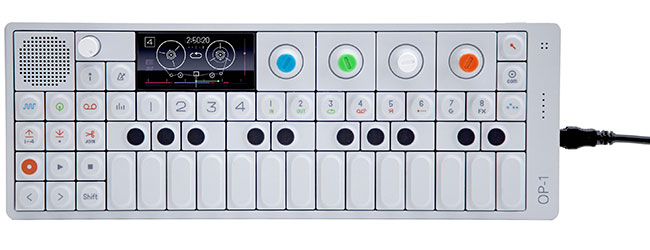
I’ve had my eyes on Teenage Engineering’s portable OP-1 synth for several years now, and I finally made the plunge and picked up a barely-used (less than 10 hours) unit from eBay. Always a bit of a risk, but this one turned out to be in perfect condition, as advertised. It’s got a very appealing Mattel®-toy vibe, but the bright colors and tiny size don’t change the fact that this little guy is actually an extremely flexible and powerful tool.
My intention is to use its unique capabilities to create one-off sound events that would be difficult or impossible to manage with my other instruments, and then bring them into the studio to be assembled via my DAW. It’s apparent that there are lots of possibilities for round-tripping, where audio is exported from the studio into the OP-1, manipulated, and then returned to the DAW. But not to put too fine a point on things… whatever other goals I have for the OP-1, ultimately it’s all about FUN.
This week, I’ll be taking Amtrak to New York City for Keith Jarrett’s solo performance at Carnegie Hall; according to the New York Times, it’s the only solo concert he’ll be performing this year. I was there for his 2005 concert, which was released by ECM on CD, and it was an extraordinary experience. I’m expecting the sublime… but I’ll be taking advantage of the round trip to spend some quality time being ridiculous with the OP-1. Since all of my headphones are open-backed Grados, I’ve thoughtfully picked up a pair of closed-back Sennheisers so I can bop to my heart’s content without being thrown off the train. I’m looking forward to a fantastic couple of days.
When I was finishing my time as a student at Brown, a couple of events took place that had me thinking “Of course! I should have known… just as I’m leaving…” The music department moved to a snazzy new building just around the corner from the student co-op where I was living, and the electronic music studio acquired a Synclavier – an early digital sampling, FM/additive synthesis beast. This was a very big-ticket item at the time; guitarist Pat Metheny and well-known iconoclast/composer/guitar virtuoso Frank Zappa each made extensive use of the instrument. I never actually got hands-on experience with it, though I did witness a demo that left me agog. (sigh)
Of course, during the ’80s I was able to go hands-on with sampling (Casio FZ-1, among others) and FM synthesis (the ground-breaking Yamaha DX7, TX-7 and TX816!) but never got any significant experience with additive synthesis beyond Hammond organs (yes, that’s what those drawbars are all about) and some relatively primitive work with the Apple II+ based Alpha Syntauri. (Still, I had a *lot* for affection for the Syntauri; it was my first digital instrument.)
That’s a shame, because additive synthesis can be an extraordinarily powerful technique, and can produce extremely complex, utterly dazzling sounds that no other technique can manage. It can be a beast though, as you’re literally building sounds harmonic by harmonic, assembling individual sine waves into your final sound. If you’re going to produce anything beyond unchanging organ tones, each harmonic will need to be given an amplitude envelope of its own, and things can get ridiculously complicated in a hurry.
I’ve just come across a soft synth that promises to make additive synthesis accessible, manageable, and more mainstream. While following NAMM coverage, I learned about AIR Music Technology’s Loom soft synth. Apparently it’s been out for about a year, but it’s news to me.
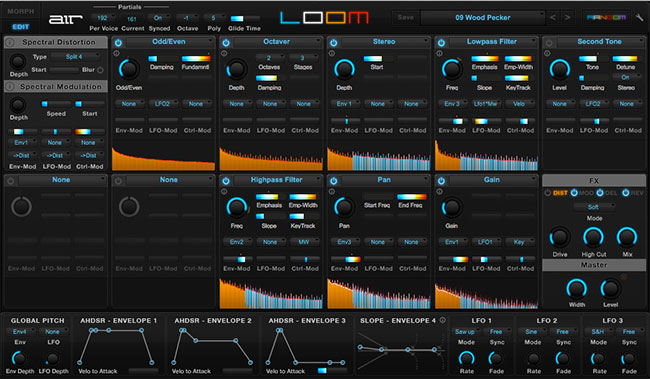
And what news it is. On the basis of a couple reviews and a few demo sounds, I went ahead and purchased the plug-in… and immediately disappeared down the rabbit hole. While simply auditioning presets, I was hearing things I’d never heard from any other instrument I’ve played; just holding down a few notes was enough to produce evolving tone clusters that evoked Gyorgy Ligeti’s Atmospheres. In case you can’t tell, I’m very, very excited about this new tool, and looking forward to putting in the time to get to know it inside-out. I believe the Seaboard will be well-suited for controlling individual sound parameters in real time, and like Kyma, I can’t wait to marry the two!
If you’ve stuck with me through this post, thanks for hanging in there. I’m planning to keep them coming more regularly, and I have high hopes that the Seaboard will be here soon to help me do just that. I’ve got to start earning my domain name!
Kyma Arrives
It’s been a remarkable few days. My new Kyma system (pronounced KEE-muh, not k-EYE-muh, as I had always thought) arrived on Monday. Unfortunately, my studio wasn’t quite ready for its new resident; as an audio supercomputer in its own right, the Pacarana hardware engine that Kyma uses for its actual computation requires a dedicated audio interface all its own. It can’t just share the existing interface, which has been tasked with serving Digital Performer and feeding the result to my surround monitoring system.
So in order to get started with Kyma, I had to wait until Tuesday for its new MOTU 828mk3 interface to arrive. But because I’ll be using Kyma for surround production – and my old Mackie interface doesn’t support ADAT, which I need to port eight channels of digital surround information from the Kyma to Digital Performer – I’ll need to replace the old Mackie with a second MOTU 828mk3! Ouch - it’s amazing how quickly the investment snowballs.
But this works out very well, as the MOTU interfaces can multiplex their 16 ADAT channels to deliver eight 96K S/MUX channels. Perfect for sharing the Pacarana’s surround output with the outside world. But one step at a time… first, I needed to get Kyma up and running with its own interface; headphones would suffice until I ordered the second interface.
Anyone who has worked with digital audio knows that getting computers, interfaces, and assorted processors and other devices to all shake hands and play happily together can be a challenge. It gets more challenging as the signal chain grows more complex. Getting Kyma up and running was no exception; I read and paid close attention to all the documentation that Symbolic Sound provided for Kyma. Still, it took me 5 hours – and many, many cycles of rebooting and restarting the interfaces and Pacarana – to finally get everything up and running properly. It took forever to keep it from crashing on launch.
But what a reward! From the first robotic voice example to far more complex networks of organic trippiness, I was blown away by the clarity, complexity and unique attributes of the sounds I was hearing. I wasn’t doing anything but playing back Sounds (as they’re called in Kyma syntax) that other people had created, but I was dazzled and inspired to invest the time it’s going to take to learn this system inside out. It’s a worldbeater, and everything I’d heard about it all these years was true.
Finally, satisfied at last that I had all my Kyma ducks in a row, I powered down and went out for breakfast at 7:30pm – yes, I had been very focused all day. Taking my iPad with me, I saw that my registration for the Kyma Tweaky website (a pun on “wiki”) had been approved. It’s a very substantial repository of the collective experience and knowledge of Kyma users worldwide, and I’m looking forward to downloading and auditioning resources. I started off by visiting the “News” section to see what was up in KymaLand.
Guess what. There had been a new software release – along with new firmware for the Pacarana – posted on October 26, while my Kyma was in a box somewhere in the FedEx system on its way to me. Among the features of this new release was a bug fix for a change in Apple’s new Mavericks OS that was causing crashes when Kyma was trying to start up. Sound familiar?
I stared at my iPad, gin and tonic in hand. While I would have been happy to avoid the struggle I had experienced getting up and running, I have to admit that my many years of debugging systems have served me well – I had managed to find a workaround despite a fairly serious software bug, and I’m proud of that. Still, it’s nice to know that the Kyma system is actually more robust than I was wondering at first. And while I didn’t want to be the typical newb that couldn’t figure out how to get his new instrument up and running, next time – if there is a next time – perhaps a quick email to Symbolic Sound could spare me from repeating the wasted effort I hope I’ve put behind me.
So that’s Day One! Believe me, it was worth the struggle. Today I’m waiting for more Firewire cables and a hub to arrive so I can put the Pacarana in the rack where it belongs, instead on on a table in the middle of the studio. I’m writing this long-overdue blog post while I wait.
And it is overdue; I had promised to write more about ROLI’s visit to New York, which is now fading into the rear-view mirror of memory. I had a great time, and hope the videos I posted did a good job of documenting the experience. I never got around to cranking out a 3D version of the second video; frankly, while at first I thought it would be interesting, the awful anaglyph encoding (the red/cyan glasses) I’m forced to use for web delivery takes all the fun out of it. It looks soooo much better with polarized shutter glasses. While I’m not saying I’ll never use it here again, I can do a much better job with other cameras I have available, and that will likely be the route I take with my studio videos in the future.
And with all the talk about Kyma, I didn’t even mention the Seaboard! Naturally, I’m looking forward to using the two together – or “mating” them, as I’ve said elsewhere. I believe the Seaboard will work profoundly well with Kyma – both as a source of audio, and particularly as a control device – as the Seaboard is all about delivering uniquely hands-on control information. I consider myself lucky to have this time before the Seaboard arrives to develop a certain level of expertise with Kyma, so I’ll be in better shape to use it well when it gets here.
Just one more thing… there’s another reason it’s taken me a while to get this blog post out; I’ve been experiencing some fairly major changes recently. Just a little over a week ago, I did something that many people only get to dream of doing; I quit my day job. I’d been doing consulting work for a local agency for over 14 years; sometimes the nature of the work was great, and sometimes it wasn’t. There were people there I considered to be friends, but at least one whose actions… well, remember Biff from Back to the Future? With the exception of the good friends I’m staying in contact with, all that’s behind me now.
I’ve taken the leap into doing the creative work that I should be doing full time; be it music or animation, photography or cinematography, art or commerce… I’m going to make this happen. As Thoreau said: “If one advances confidently in the direction of his dreams, and endeavors to live the life which he has imagined, he will meet with success unexpected in common hours.”
Sorry about all those male pronouns; this aspiration applies to everyone – but you know what I mean. The Seaboard will play a major role in what I hope to accomplish, and I hope I can keep you interested enough to follow the process here. Thanks for reading!
ROLI and the Seaboard Visit New York
This past Friday, October 11, the folks from ROLI gave the Seaboard its North American debut in New York City. I was lucky enough to be there, and here’s a little sample of what it was like.
There will be more later – including a 3D version – but for tonight, I just want to get this up and online. More to say tomorrow! :)
Jordan Rudess at the Seaboard
One of the many highlights of ROLI’s Friday visit to New York was Dream Theater keyboardist Jordan Rudess’s hands-on Seaboard demo. Click through to find two edits - the standard video, and the extra bonus 3D version. Both feature the same content, but if you have a pair of anaglyph glasses, you can watch in the miracle of stereo 3D!
(more)
First Things First
Yesterday was a significant day in my nascent personal Seaboard saga. I woke at 6:00am EDT, and decided to try calling London before the rest of the U.S. stirred and got the same idea. I wrestled with the international number for several attempts – did you know that if you hold down the zero key on an iPhone, it turns into a “plus” sign? – and eventually was rewarded with the pleasant British voice of ROLI’s receptionist.
I gave my name and asked for Danny, the sales consultant who’s been my contact at ROLI. I was told “Certainly, but first let me connect you with Roland.” I was, frankly, still half asleep and a bit confused, and it took me several seconds before I realized that the person I was now speaking with was Roland Lamb, founder of ROLI and the man whose vision led to the invention of the Seaboard.
I was a little flustered; this fellow had only a few days earlier been speaking on BBC World and CNN, and now he was burdened with a bleary-eyed American who wasn’t quite up to speed for morning conversation. Still, his warmth and genuine interest in greeting one of his first customers broke the ice quickly. He’s a busy fellow, but it was a pleasure to chat with him for a few moments; he was aware of my newborn blog, and I was happy to let him know of my plans for sharing my experiences with the Seaboard.
I thought it was rather remarkable that the CEO of a company had left word at the front desk (as he almost certainly would have had to) that he be given the opportunity to speak with his early adopters; the speed with which I was connected was part of what caught me by surprise.
After wishing Roland all the best, I had the chance to speak with Danny at some length, a very enjoyable conversation despite (from my point of view) the early hour. We took care of the brass tacks of transferring the deposit, and I was now officially one of the lucky ones in the queue, awaiting one of the very first Seaboards to roll out of ROLI’s doors.
Danny also went to the trouble of inquiring about my t-shirt and sweatshirt sizes, as I was to be graced with the additional prize of a wearable token that I was now a member of the ROLI family. I promise that when it arrives, you’ll see it here first. Can’t wait!
I also dropped broad hints about my personal preference when it came to the key number to be engraved on the back of my Seaboard. Danny let me know that they were a fair ways away from beginning to assign individual key numbers, but I wasn’t too embarrassed to speak up for what I might prefer, if I happened to have my ‘druthers.
The first keyboard I ever played was on a (then new) Hammond organ, and much of my early keyboard fanaticism involved doing my best to emulate Keith Emerson’s chops. So with the thought of binding the new with a touchstone from the past, I voiced my fondness for Hammond models C3 and B3, knowing full well I may have arrived too late to have a chance. After hearing Jordan Rudess’s remarkable version of Emerson’s Tarkus, it wouldn’t surprise me at all if he’d beaten me to the draw. Still, nothing ventured, nothing gained – and in truth, I know I’ll be head over heels with whichever Seaboard winds up in my life.
Could it possibly happen by December? Patience is key, but it’s certainly true that I’ll be keeping my eyes on the calendar, and hoping for an extraordinary Christmas. C’mon, Santa – I’ve been extra good this year!
A Blog is Born
It’s been a long day. ROLI surprised everyone with the announcement of two new readily-affordable models of their Seaboard GRAND, and I registered and coded this fledgling website.
By the time I have something to say, this initial entry will have long since scrolled off the bottom of the page into obscurity. But for those who happen to see this – perhaps even some curious denizens of ROLI, taking a break from their labors – I promise to do my best to make it an interesting place to visit, worthy of the cool domain name I scarfed up.
I can be quick on the draw with these web projects; for many years, I was worldpeace.com, but as we all know, there doesn’t seem to be much of a market for that sort of thing. I’m sure the Seaboard will do much better.
And in case there actually are visitors dropping by from ROLI, let me assure you… I promise to use my powers for good, not evil. And let me wish for more power to all of you; you’re doing wonderful, amazing things, and you have my sincere thanks.
Flaubert on Language
“… but human language is like rhythms we beat out on cracked kettles for bears to dance to, when what we want is to make music that will wring tears from the stars.”
— Gustave Flaubert, Madame Bovary
